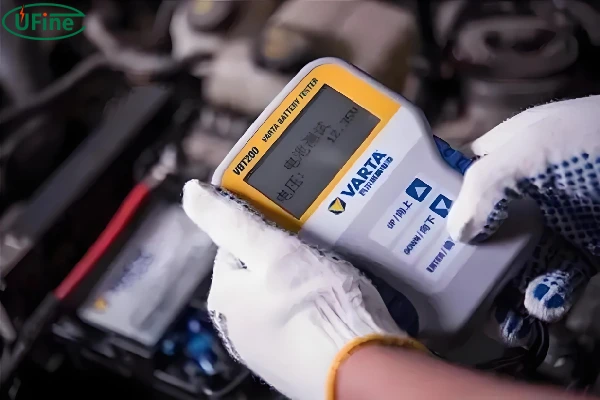Choosing the correct battery can be challenging, especially with so many available options. Group 27 deep cycle batteries are a popular choice for many applications. Whether you’re powering a boat, RV, or a backup power system, these batteries offer a reliable and efficient power source. In this guide, we’ll dive into what Group 27 deep cycle batteries are, their types, parameters, advantages, how to charge them, and maintenance tips. Let’s get started!
Part 1. What is Group 27 deep cycle battery?
A Group 27 deep cycle battery is designed to provide a steady amount of power over a long period of time. Unlike regular car batteries, which deliver a quick burst of energy to start an engine, deep cycle batteries are built to discharge and recharge many times. They are commonly used in marine applications, RVs, and backup power systems due to their ability to provide consistent power output over extended periods.
Key Characteristics
Deep Discharge Capability: Designed to be discharged to a significant extent before recharging.
Durability: Built to withstand repeated cycles of discharging and recharging.
Versatility: Suitable for a wide range of applications, including marine, RV, and backup power systems.
Part 2. Types of Group 27 deep cycle battery
There are several types of Group 27 deep cycle batteries available, each with its own set of characteristics, advantages, and disadvantages. Here’s a closer look at each type:
1.Group 27 Deep Cycle Flooded Lead-Acid Batteries
- Characteristics: These are the traditional type of deep cycle batteries. They contain liquid electrolytes and require regular maintenance, such as adding distilled water.
- Pros: Generally the most affordable option.
- Cons: Requires regular maintenance and must be kept upright to prevent leaks.
2. Group 27 Deep Cycle AGM (Absorbent Glass Mat) Batteries
- Characteristics: These batteries use a glass mat to absorb the electrolyte, making them spill-proof and maintenance-free.
- Pros: Maintenance-free, highly resistant to vibration, and can be mounted in various positions.
- Cons: More expensive than flooded lead-acid batteries.
3. Group 27 Deep Cycle Gel Batteries
- Characteristics: These batteries use a gelled electrolyte, which makes them spill-proof and capable of operating in various positions.
- Pros: Maintenance-free, performs well in extreme temperatures and has a longer lifespan.
- Cons: More expensive and less efficient in high-drain applications compared to AGM batteries.
4. Group 27 Deep Cycle Lithium-Ion Batteries
- Characteristics: These are the newest type of deep cycle batteries, offering the highest performance and efficiency.
- Pros: Lightweight, long lifespan, fast charging, and maintenance-free.
- Cons: Most expensive and requires specific charging equipment.
Part 3. Group 27 deep cycle battery parameters
Understanding the key parameters of Group 27 deep cycle batteries will help you choose the right battery for your needs. Here are the primary parameters to consider:
1. Dimensions
Group 27 batteries typically measure around 12.1 inches in length, 6.8 inches in width, and 8.9 inches in height. These dimensions can vary slightly depending on the manufacturer and battery type.
2. Weight
The weight of Group 27 batteries varies depending on the type. Flooded lead-acid batteries are generally the heaviest, weighing around 50 to 60 pounds. AGM and gel batteries are slightly lighter, while lithium-ion batteries are the lightest, often weighing less than 30 pounds.
3. Voltage
The standard voltage for Group 27 deep cycle batteries is 12 volts. This voltage is suitable for most marine, RV, and backup power applications.
4. Capacity
The capacity of Group 27 deep cycle batteries typically ranges from 70 to 100 amp-hours (Ah). This capacity indicates how much power the battery can store and deliver over time. Higher capacity batteries can provide power for longer periods before needing to be recharged.
5. Price
The cost of Group 27 deep cycle batteries varies widely based on the type and brand. Flooded lead-acid batteries are the most affordable, starting at around $100. AGM and gel batteries are more expensive, typically ranging from $150 to $250. Lithium-ion batteries are the most expensive, often costing several hundred dollars.
Part 4. Group 27 deep cycle battery advantages
Group 27 deep cycle batteries offer several advantages, making them a popular choice for various applications. Here are some of the key benefits:
1. Long Lifespan
Durability: These batteries are designed to withstand many charge and discharge cycles, making them a long-lasting power source.
Cycle Life: They can be deeply discharged and recharged many times without significant loss of capacity.
2. Steady Power Supply
Consistency: Provides a reliable and steady power output over extended periods, essential for applications like RVs and boats.
Performance: They maintain a consistent voltage level until they are almost fully discharged.
3. Versatility
Wide Application: Suitable for a variety of uses, including marine, RV, solar power systems, and backup power.
Multiple Types: Available in different types (flooded, AGM, gel, lithium-ion) to suit specific needs and preferences.
4. Maintenance Options
Low Maintenance: Options like AGM, gel, and lithium-ion batteries require little to no maintenance.
User-Friendly: Flooded batteries, while requiring maintenance, are straightforward to manage with regular care.
5. Safety Features
Spill-Proof: AGM, gel, and lithium-ion batteries are sealed and spill-proof, reducing the risk of acid leaks.
Robust Construction: Designed to resist vibrations and shocks, making them safe for mobile applications.
Part 5. How to charge Group 27 deep cycle battery?
Proper charging is crucial to extend the life and performance of your Group 27 deep cycle battery. Follow these steps to ensure correct charging:
Step 1: Choose the Right Charger
Compatibility: Ensure the charger suits your specific battery type (flooded, AGM, gel, or lithium-ion).
Specifications: Check the charger’s voltage and current output to match your battery’s requirements.
Step 2: Connect the Charger
Safety First: Before connecting, make sure the charger is turned off.
Correct Polarity: Attach the positive (red) lead to the positive terminal of the battery and the negative (black) lead to the negative terminal.
Step 3: Set the Charger
Appropriate Setting: Select the correct charging mode or setting based on your battery type. For example, AGM and gel batteries may have specific modes on the charger.
Step 4: Start Charging
Monitor: Turn on the charger and monitor the charging process. Modern chargers often have indicators or displays to show the charging status.
Avoid Overcharging: Many chargers automatically shut off or switch to a maintenance mode once the battery is fully charged.
Step 5: Disconnect Safely
Power Off: Turn off the charger before disconnecting the leads.
Remove Leads: Disconnect the negative lead first, followed by the positive lead.
Part 6. Group 27 deep cycle battery maintenance tips

Proper maintenance can significantly extend the life of your Group 27 deep cycle battery. Here are some essential tips:
1. Regularly Check Voltage
Monitor Levels: Use a voltmeter to check the battery’s voltage regularly. Keep it within the recommended range to prevent deep discharges and overcharging.
2. Clean Terminals
Prevent Corrosion: Clean the battery terminals regularly to prevent corrosion. Use a mixture of baking soda and water to clean the terminals if corrosion is present.
Secure Connections: Ensure all connections are tight and secure.
3. Maintain Charge Levels
Avoid Deep Discharges: Try to recharge the battery before it drops below 50% capacity to extend its lifespan.
Proper Storage: If storing the battery for an extended period, ensure it is fully charged and stored in a cool, dry place.
4. Inspect for Damage
Regular Checks: Inspect the battery for any signs of damage, such as cracks or leaks. If you notice any damage, replace the battery immediately.
Safety Measures: Always handle batteries with care to avoid physical damage.
5. Use the Right Charger
Match Specifications: Always use a charger compatible with your battery type and specifications.
Intelligent Chargers: Consider using a smart charger that can automatically adjust the charging process to prevent overcharging and maintain optimal battery health.
By understanding the different types of Group 27 deep cycle batteries, their parameters, advantages, and how to properly charge and maintain them, you can make an informed decision and ensure your battery lasts longer and performs better. Whether you need a reliable power source for your RV, boat, or backup power system, Group 27 deep cycle batteries offer a versatile and efficient solution.
Related Tags:
More Articles

Standard 24 Group Battery Dimensions Explained
What is 24 Group battery standard dimension? Find out now and choose the right battery for your needs. Don’t wait—get informed!
How Cobalt Free Batteries Are Transforming the Electric Vehicle Market?
Cobalt-free batteries are transforming the electric vehicle market with a sustainable choice. This article explores their benefits, challenges, and potential.
Lithium Manganese Batteries: A Comprehensive Guide
Lithium manganese batteries are transforming energy storage. This guide covers their mechanisms, advantages, applications, and limitations.
12 Volt 100Ah Lithium Battery: 12 Important Facts
Want to know about 12 Volt 100Ah lithium batteries? Explore essential facts that reveal their advantages and uses. Get informed today!
Why Choose a UPS Lithium Battery for Your Power Backup Needs?
Choosing the right battery for UPS systems is vital. UPS lithium batteries offer superior performance and longevity, making them perfect for power backup needs.





